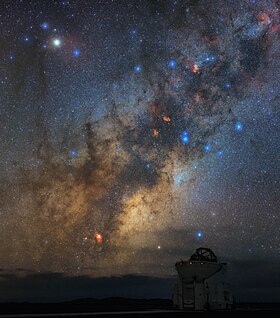WR 93b is a Wolf-Rayet star in the constellation Scorpius, an extremely rare star on the WO oxygen sequence. It appears near NGC 6357 in the tail of the scorpion.
| Observation data Epoch J2000.0 Equinox J2000.0 | |
|---|---|
| Constellation | Scorpius |
| Right ascension | 17h 32m 03.308s[1] |
| Declination | −35° 04′ 32.62″[1] |
| Apparent magnitude (V) | 15.2[2] |
| Characteristics | |
| Evolutionary stage | Wolf-Rayet star |
| Spectral type | WO3[3] |
| Apparent magnitude (B) | 16.9[4] |
| Apparent magnitude (R) | 14.4[4] |
| Apparent magnitude (J) | 11.331[4] |
| Apparent magnitude (K) | 10.17[5] |
| Astrometry | |
| Proper motion (μ) | RA: −0.642±0.032[1] mas/yr Dec.: −2.1055±0.024[1] mas/yr |
| Parallax (π) | 0.4298 ± 0.0288 mas[1] |
| Distance | 7,600 ± 500 ly (2,300 ± 200 pc) |
| Details | |
| Mass | 8.1+1.9 −1.2[6] M☉ |
| Radius | 0.44[6] R☉ |
| Luminosity | 110,000+53,000 −30,000[6] L☉ |
| Temperature | 160,000[3] K |
| Other designations | |
| Database references | |
| SIMBAD | data |
Discovery
editWR 93b was discovered in 2003 during a study of emission line stars from the AAO/UKST Southern Galactic Plane Hα Survey. It was published as the fourth galactic WO class star in 1994.[7] This was too late to be included in the VIIth Wolf Rayet catalogue,[8] but it is listed in an annex published in 2006.[5]
It lies in the direction of the Galactic Center and is thought to be part of the Scutum-Crux spiral arm. It is highly reddened and interstellar extinction causes it to be 6.5 magnitudes fainter at visual wavelengths than it otherwise would be.[7]
Features
editWR 93b, of spectral classification WO3, is one of the very few known oxygen-sequence Wolf-Rayet stars, just four in the Milky Way galaxy and six in external galaxies. Modelling the atmosphere gives a luminosity around 110,000 L☉, very low for a Wolf-Rayet star.[6] It is a very small dense star, with a radius less than half of the sun's but with a mass nearly 10 solar masses. Very strong stellar winds, with a terminal velocity of 5,000 kilometers per second are causing WR 93b to lose 10−5 M☉/year.[3] For comparison, the Sun loses (2-3) x 10−14 solar masses per year due to its solar wind, several hundred million times less than WR 93b.
Evolutionary status
editWO Wolf-Rayet stars are the last evolutionary stage of the most massive stars before exploding as supernovae, possibly with a gamma-ray burst.[9] It is very likely that WR 93b is on its last stages of nuclear fusion, near or beyond the end of helium burning.[10] It has been calculated that WR 93b will explode as a supernova within 8,000 years.[3]
See also
editReferences
edit- ^ a b c d e Brown, A. G. A.; et al. (Gaia collaboration) (2021). "Gaia Early Data Release 3: Summary of the contents and survey properties". Astronomy & Astrophysics. 649: A1. arXiv:2012.01533. Bibcode:2021A&A...649A...1G. doi:10.1051/0004-6361/202039657. S2CID 227254300. (Erratum: doi:10.1051/0004-6361/202039657e). Gaia EDR3 record for this source at VizieR.
- ^ Henden, Arne A.; Levine, Stephen; Terrell, Dirk; Welch, Douglas L. (2015). "APASS - the Latest Data Release". American Astronomical Society Meeting Abstracts #225. 225: 336.16. Bibcode:2015AAS...22533616H.
- ^ a b c d Tramper, F.; Straal, S. M.; Sanyal, D.; Sana, H.; de Koter, A.; Gräfener, G.; Langer, N.; Vink, J. S.; de Mink, S. E.; Kaper, L. (2015). "Massive stars on the verge of exploding: The properties of oxygen sequence Wolf-Rayet stars". Astronomy & Astrophysics. 581 (110): A110. arXiv:1507.00839v1. Bibcode:2015A&A...581A.110T. doi:10.1051/0004-6361/201425390. S2CID 56093231.
- ^ a b c Cutri, Roc M.; Skrutskie, Michael F.; Van Dyk, Schuyler D.; Beichman, Charles A.; Carpenter, John M.; Chester, Thomas; Cambresy, Laurent; Evans, Tracey E.; Fowler, John W.; Gizis, John E.; Howard, Elizabeth V.; Huchra, John P.; Jarrett, Thomas H.; Kopan, Eugene L.; Kirkpatrick, J. Davy; Light, Robert M.; Marsh, Kenneth A.; McCallon, Howard L.; Schneider, Stephen E.; Stiening, Rae; Sykes, Matthew J.; Weinberg, Martin D.; Wheaton, William A.; Wheelock, Sherry L.; Zacarias, N. (2003). "VizieR Online Data Catalog: 2MASS All-Sky Catalog of Point Sources (Cutri+ 2003)". CDS/ADC Collection of Electronic Catalogues. 2246: II/246. Bibcode:2003yCat.2246....0C.
- ^ a b Van Der Hucht, K. A. (2006). "New Galactic Wolf-Rayet stars, and candidates. An annex to the VIIth Catalogue of Galactic Wolf-Rayet Stars". Astronomy and Astrophysics. 458 (2): 453–459. arXiv:astro-ph/0609008. Bibcode:2006A&A...458..453V. doi:10.1051/0004-6361:20065819. S2CID 119104786.
- ^ a b c d Sander, A.; Hamann, W.-R.; Todt, H. (2012). "The Galactic WC stars. Stellar parameters from spectral analyses indicate a new evolutionary sequence". Astronomy & Astrophysics. 540: A144. arXiv:1201.6354. Bibcode:2012A&A...540A.144S. doi:10.1051/0004-6361/201117830. S2CID 119182468.
- ^ a b Drew, Janet E.; Barlow, M. J.; Unruh, Y. C.; Parker, Q. A.; Wesson, R.; Pierce, M. J.; Masheder, M. R. W.; Phillipps, S. (2004). "Discovery of a WO star in the Scutum-Crux arm of the inner Galaxy". Monthly Notices of the Royal Astronomical Society. 351 (1): 206–214. arXiv:astro-ph/0403482. Bibcode:2004MNRAS.351..206D. doi:10.1111/j.1365-2966.2004.07771.x. S2CID 2601618.
- ^ van der Hucht, Karel A. (2001). "The VIIth catalogue of galactic Wolf–Rayet stars". New Astronomy Reviews. 45 (3): 135–232. Bibcode:2001NewAR..45..135V. doi:10.1016/S1387-6473(00)00112-3. ISSN 1387-6473.
- ^ Groh, Jose H.; Meynet, Georges; Georgy, Cyril; Ekstrom, Sylvia (2013). "Fundamental properties of core-collapse Supernova and GRB progenitors: Predicting the look of massive stars before death". Astronomy & Astrophysics. 558: A131. arXiv:1308.4681. Bibcode:2013A&A...558A.131G. doi:10.1051/0004-6361/201321906. S2CID 84177572.
- ^ Groh, Jose (2014). "The evolution of massive stars and their spectra I. A non-rotating 60 Msun star from the zero-age main sequence to the pre-supernova stage". Astronomy & Astrophysics. 564: A30. arXiv:1401.7322. Bibcode:2014A&A...564A..30G. doi:10.1051/0004-6361/201322573. S2CID 118870118.
